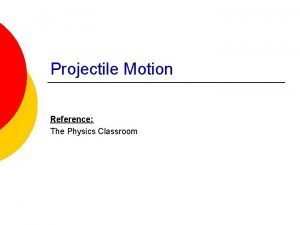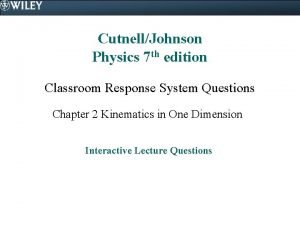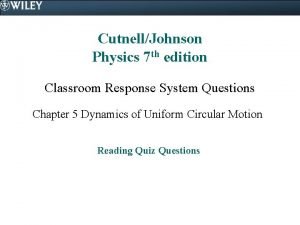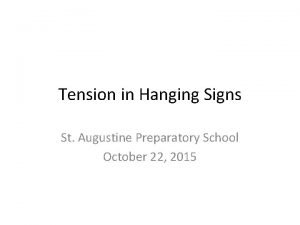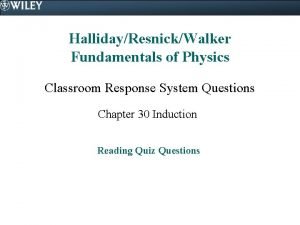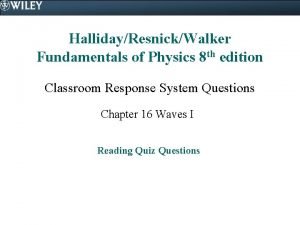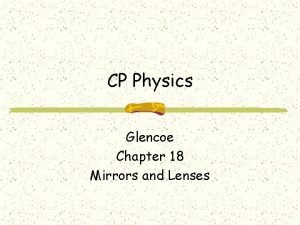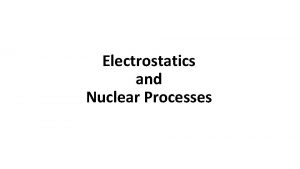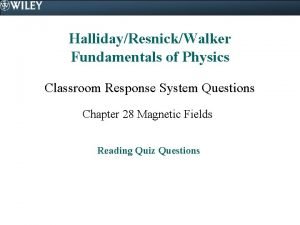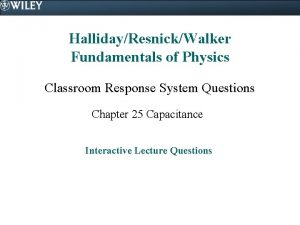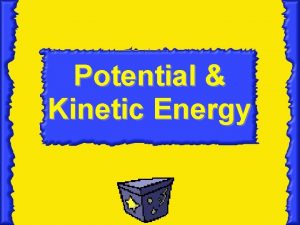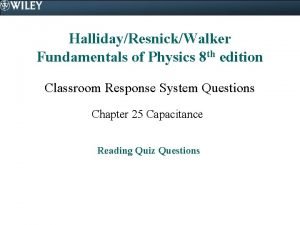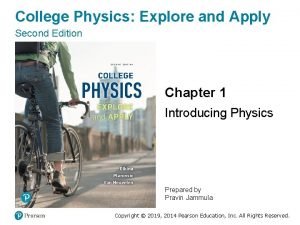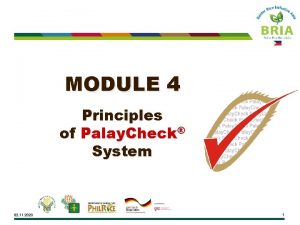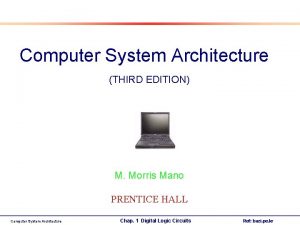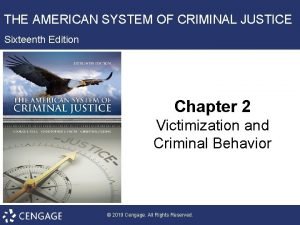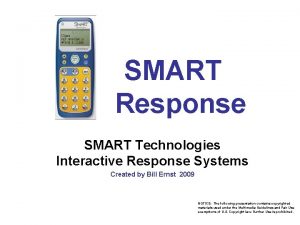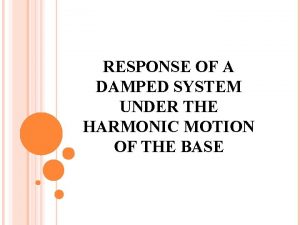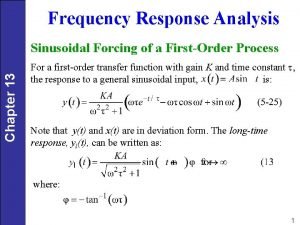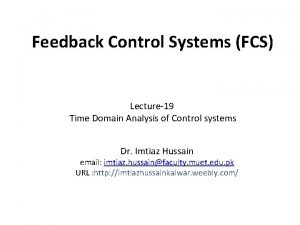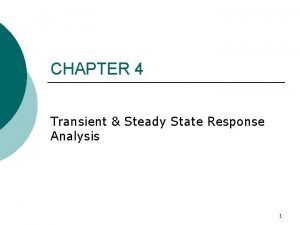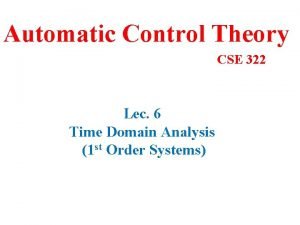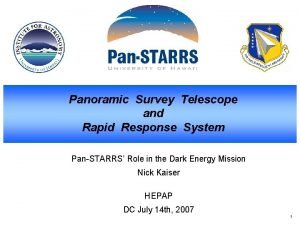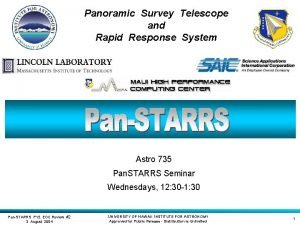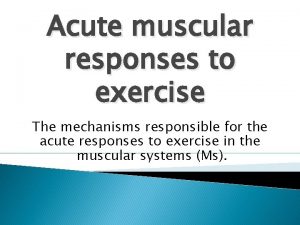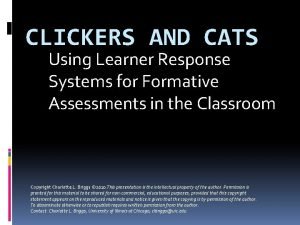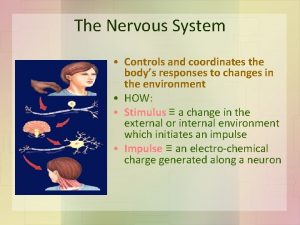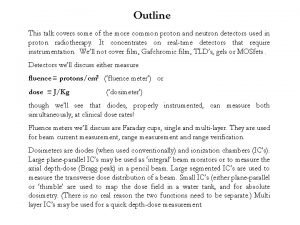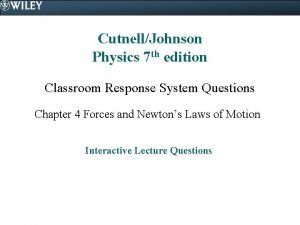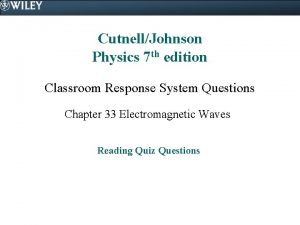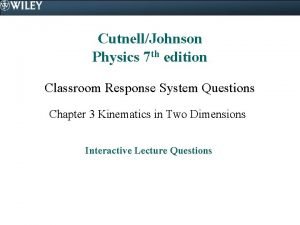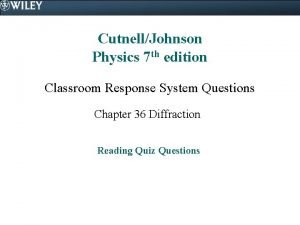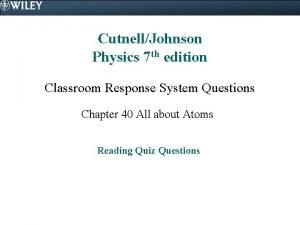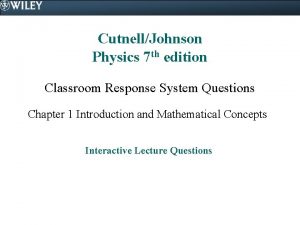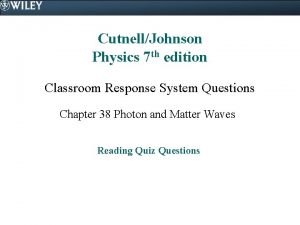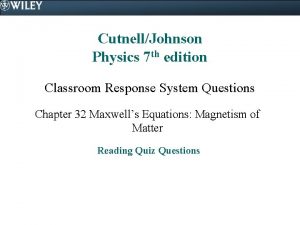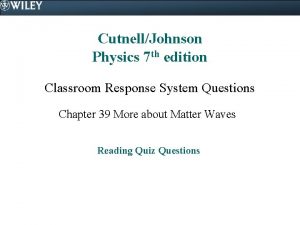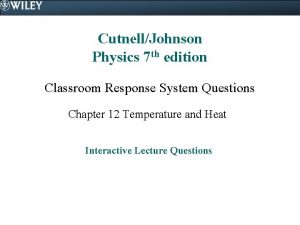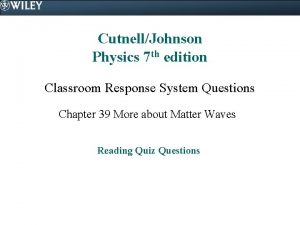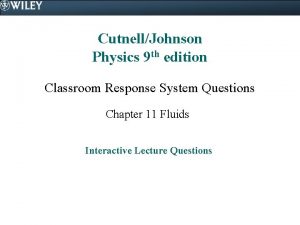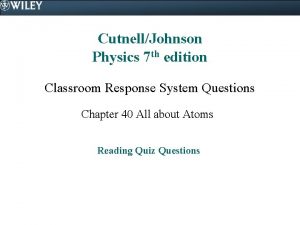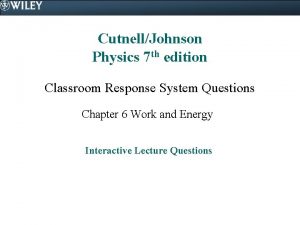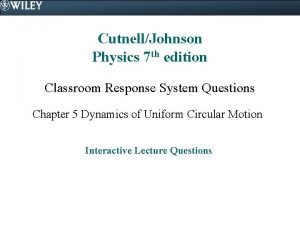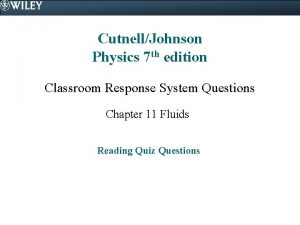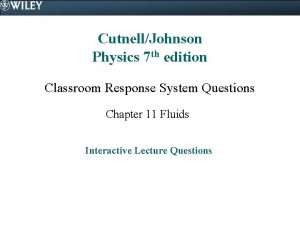CutnellJohnson Physics 7 th edition Classroom Response System















































- Slides: 47

Cutnell/Johnson Physics 7 th edition Classroom Response System Questions Chapter 37 Relativity Reading Quiz Questions

37. 1. 1. What is an inertial reference frame? a) a frame in which Newton’s laws of motion are valid b) a frame of motion that contains a large quantity of material c) any frame that serves as a reference to measure the motion of objects d) a frame that is rotating with a constant rotational speed e) a two-dimensional representation that represents an event according to the special theory of relativity

37. 1. 1. What is an inertial reference frame? a) a frame in which Newton’s laws of motion are valid b) a frame of motion that contains a large quantity of material c) any frame that serves as a reference to measure the motion of objects d) a frame that is rotating with a constant rotational speed e) a two-dimensional representation that represents an event according to the special theory of relativity

37. 1. 2. Which one of the following situations does not involve an inertial reference frame? a) A ship is traveling toward Mars at 1200 m/s. b) A railroad car is heading west out of Denver at 50 mph. c) A merry-go-round is rotating at 4 revolutions per minute. d) A helicopter hovers over a lake during a rescue attempt. e) A ship is being lowered at a constant rate in a river lock.

37. 1. 2. Which one of the following situations does not involve an inertial reference frame? a) A ship is traveling toward Mars at 1200 m/s. b) A railroad car is heading west out of Denver at 50 mph. c) A merry-go-round is rotating at 4 revolutions per minute. d) A helicopter hovers over a lake during a rescue attempt. e) A ship is being lowered at a constant rate in a river lock.

37. 2. 1. How many postulates are included in the special theory of relativity? a) 0 b) 1 c) 2 d) 3 e) 4

37. 2. 1. How many postulates are included in the special theory of relativity? a) 0 b) 1 c) 2 d) 3 e) 4

37. 2. 2. Which one of the following statements is the Relativity Postulate? a) The laws of physics are the same in all reference frames. b) All velocities are measured relative to the speed of light. c) The laws of physics are relative to the methods used to derive them. d) The laws of physics are valid only on earth. e) The laws of physics are the same in every inertial reference frame.

37. 2. 2. Which one of the following statements is the Relativity Postulate? a) The laws of physics are the same in all reference frames. b) All velocities are measured relative to the speed of light. c) The laws of physics are relative to the methods used to derive them. d) The laws of physics are valid only on earth. e) The laws of physics are the same in every inertial reference frame.

37. 2. 3. An observer on the earth sees a light pulse within a space ship moving at a constant speed of one-half the speed of light (0. 5 c). The earth-bound observer measures the speed of the light pulse as it travels from one end of the ship to the other. What speed does the observer measure for the light pulse? a) 0. 25 c b) 0. 5 c c) c d) 0. 71 c e) 1. 4 c

37. 2. 3. An observer on the earth sees a light pulse within a space ship moving at a constant speed of one-half the speed of light (0. 5 c). The earth-bound observer measures the speed of the light pulse as it travels from one end of the ship to the other. What speed does the observer measure for the light pulse? a) 0. 25 c b) 0. 5 c c) c d) 0. 71 c e) 1. 4 c

37. 2. 4. What does the speed of light postulate state? a) The speed of light in a vacuum is constant unless the viewer is moving toward or away from the light source. b) The speed of light depends on the relative velocity of the light source relative to the observer. c) The speed of light in a vacuum has the same value in all directions and in all inertial reference frames. d) The speed of light in a vacuum varies with the wavelength, but is a constant for each wavelength in all reference frames. e) Nothing can travel faster than the speed of light.

37. 2. 4. What does the speed of light postulate state? a) The speed of light in a vacuum is constant unless the viewer is moving toward or away from the light source. b) The speed of light depends on the relative velocity of the light source relative to the observer. c) The speed of light in a vacuum has the same value in all directions and in all inertial reference frames. d) The speed of light in a vacuum varies with the wavelength, but is a constant for each wavelength in all reference frames. e) Nothing can travel faster than the speed of light.

37. 3. 1. Complete the following sentence: In theory of special relativity, an event is a physical happening a) that is observed by two observers, one moving and one at rest. b) that occurs at a certain place and time. c) that occurs in an inertial reference frame. d) that occurs in an accelerating reference frame. e) that involves the emission or absorption of light.

37. 3. 1. Complete the following sentence: In theory of special relativity, an event is a physical happening a) that is observed by two observers, one moving and one at rest. b) that occurs at a certain place and time. c) that occurs in an inertial reference frame. d) that occurs in an accelerating reference frame. e) that involves the emission or absorption of light.

37. 3. 2. Complete the following sentence: An event is something that happens and can be assigned a) to an inertial reference frame. b) a time interval. c) a position. d) to a general reference frame. e) a time coordinate and three space coordinates.

37. 3. 2. Complete the following sentence: An event is something that happens and can be assigned a) to an inertial reference frame. b) a time interval. c) a position. d) to a general reference frame. e) a time coordinate and three space coordinates.

37. 4. 1. On what does simultaneity depend? a) the type of events b) the type of clocks used c) the motion of the observer d) the scale of the event

37. 4. 1. On what does simultaneity depend? a) the type of events b) the type of clocks used c) the motion of the observer d) the scale of the event

37. 5. 1. Which of the following statements concerning time dilation is false? a) Time is dilated relative to the proper time. b) For two observers, one moving and one at rest, in an inertial reference frame, time passes more slowly for the observer at rest. c) For two observers, one moving and one at rest, in an inertial reference frame, the proper time is measured by the observer at rest with respect to the event and observes the event at the same location. d) An astronaut that travels away from the earth at 0. 5 c and returns at the same speed. The ships clock may indicate that one year has passed, but earthbound clocks will indicate that much more time has passed. e) One confirmation of time dilation came from experiments performed by Hafele and Keating.

37. 5. 1. Which of the following statements concerning time dilation is false? a) Time is dilated relative to the proper time. b) For two observers, one moving and one at rest, in an inertial reference frame, time passes more slowly for the observer at rest. c) For two observers, one moving and one at rest, in an inertial reference frame, the proper time is measured by the observer at rest with respect to the event and observes the event at the same location. d) An astronaut that travels away from the earth at 0. 5 c and returns at the same speed. The ships clock may indicate that one year has passed, but earthbound clocks will indicate that much more time has passed. e) One confirmation of time dilation came from experiments performed by Hafele and Keating.

37. 5. 2. While traveling at 2. 5 108 m/s on a space ship in a distant galaxy, the ship’s science officer turns on a laser that sends out pulses at regular intervals the follow a long path before returning to a detector next to the laser. The equipment is used to measure the speed of light by measuring the time for the light pulses to travel from the laser to the detector. Meanwhile, an observer at rest on a nearby planet monitors the experiment. What is the term used to describe the time interval measured by the science officer on the ship? a) special time interval b) situational time interval c) relative time interval d) relative time interval e) proper time interval

37. 5. 2. While traveling at 2. 5 108 m/s on a space ship in a distant galaxy, the ship’s science officer turns on a laser that sends out pulses at regular intervals the follow a long path before returning to a detector next to the laser. The equipment is used to measure the speed of light by measuring the time for the light pulses to travel from the laser to the detector. Meanwhile, an observer at rest on a nearby planet monitors the experiment. What is the term used to describe the time interval measured by the science officer on the ship? a) special time interval b) situational time interval c) relative time interval d) relative time interval e) proper time interval

37. 5. 3. On what does the time interval between two events depend? a) the lapse in time between the two events b) the spatial distance between the two events c) the types of clocks used to make time measurements d) both temporal and spatial distances between the events

37. 5. 3. On what does the time interval between two events depend? a) the lapse in time between the two events b) the spatial distance between the two events c) the types of clocks used to make time measurements d) both temporal and spatial distances between the events

37. 6. 1. A space ship leaves the earth and travels to Alpha Centauri at a speed close to the speed of light. Passengers aboard the ship measure the distance from the earth to Alpha Centauri and the distance is also measure by scientists on earth. Which observers measure the proper length and which observer measures the shortest length? a) The passengers measure the proper length and the passengers measure the shorter length. b) The passengers measure the proper length and the scientists measure the shorter length. c) The scientists measure the proper length and the passengers measure the shorter length. d) The scientists measure the proper length and the scientists measure the shorter length. e) The passengers measure the proper length and all observers measure the same length.

37. 6. 1. A space ship leaves the earth and travels to Alpha Centauri at a speed close to the speed of light. Passengers aboard the ship measure the distance from the earth to Alpha Centauri and the distance is also measure by scientists on earth. Which observers measure the proper length and which observer measures the shortest length? a) The passengers measure the proper length and the passengers measure the shorter length. b) The passengers measure the proper length and the scientists measure the shorter length. c) The scientists measure the proper length and the passengers measure the shorter length. d) The scientists measure the proper length and the scientists measure the shorter length. e) The passengers measure the proper length and all observers measure the same length.

37. 6. 2. What is the meaning of the word “proper” in the terms proper length and proper time? a) The observer measuring the proper length or proper time is the one that is at rest with respect to the events or distance measurements being made. b) The observer measuring the proper length or proper time is the one in the preferred reference frame. c) The observer measuring the proper length or proper time is the one that is moving at large velocities with respect to an inertial reference frame. d) The observer measuring the proper length or proper time is the one located at the origin of an inertial reference frame. e) The observer measuring the proper length or proper time is the one with the most accurate measurement equipment.

37. 6. 2. What is the meaning of the word “proper” in the terms proper length and proper time? a) The observer measuring the proper length or proper time is the one that is at rest with respect to the events or distance measurements being made. b) The observer measuring the proper length or proper time is the one in the preferred reference frame. c) The observer measuring the proper length or proper time is the one that is moving at large velocities with respect to an inertial reference frame. d) The observer measuring the proper length or proper time is the one located at the origin of an inertial reference frame. e) The observer measuring the proper length or proper time is the one with the most accurate measurement equipment.

37. 6. 3. Which of the following statements concerning the proper length is true? a) The proper length is always the same as that measured in any other reference frame. b) The proper length is always longer than that measured in any other reference frame. c) The proper length is always shorter than that measured in any other reference frame. d) The proper length has no relationship to the length measured in any other reference frame.

37. 6. 3. Which of the following statements concerning the proper length is true? a) The proper length is always the same as that measured in any other reference frame. b) The proper length is always longer than that measured in any other reference frame. c) The proper length is always shorter than that measured in any other reference frame. d) The proper length has no relationship to the length measured in any other reference frame.

37. 7. 1. Which one of the following statements is not a consequence of the Lorentz equations? a) Moving clocks run faster than when they are not moving. b) Moving objects appear shorter than when they are not moving. c) Events that are simultaneous in one frame will not be simultaneous in another. d) All of the above choices are consequences of the Lorentz equations.

37. 7. 1. Which one of the following statements is not a consequence of the Lorentz equations? a) Moving clocks run faster than when they are not moving. b) Moving objects appear shorter than when they are not moving. c) Events that are simultaneous in one frame will not be simultaneous in another. d) All of the above choices are consequences of the Lorentz equations.

37. 7. 2. Consider these equations: (1) x = x vt and (2) t = t. What is the name given to these equations? a) Einstein transformation equations b) Galilean transformation equations c) Poincare transformation equations d) Lorentz transformation equations

37. 7. 2. Consider these equations: (1) x = x vt and (2) t = t. What is the name given to these equations? a) Einstein transformation equations b) Galilean transformation equations c) Poincare transformation equations d) Lorentz transformation equations

37. 9. 1. A space ship is traveling at 0. 7 c when a laser beam is turned on that is directed in the direction the ship is traveling. What is the speed of the laser light? a) 1. 0 c b) 1. 7 c c) 0. 7 c d) 1. 4 c e) 0. 3 c

37. 9. 1. A space ship is traveling at 0. 7 c when a laser beam is turned on that is directed in the direction the ship is traveling. What is the speed of the laser light? a) 1. 0 c b) 1. 7 c c) 0. 7 c d) 1. 4 c e) 0. 3 c

37. 10. 1. In the discussion of the Doppler effect for electromagnetic waves, this effect differs from that of sound waves in which of the following ways? a) The Doppler effect for electromagnetic waves requires that both the observer and the source be moving with respect to a medium. b) The Doppler effect for electromagnetic waves requires that the speed of light be measured with respect to a stationary reference frame. c) The Doppler effect for electromagnetic waves is dependent on the relative speed of the source and observer. d) The frequency of the electromagnetic waves is unaffected by the relative motion of an observer and a source. e) The Doppler effect is not present when the light is passing through a vacuum.

37. 10. 1. In the discussion of the Doppler effect for electromagnetic waves, this effect differs from that of sound waves in which of the following ways? a) The Doppler effect for electromagnetic waves requires that both the observer and the source be moving with respect to a medium. b) The Doppler effect for electromagnetic waves requires that the speed of light be measured with respect to a stationary reference frame. c) The Doppler effect for electromagnetic waves is dependent on the relative speed of the source and observer. d) The frequency of the electromagnetic waves is unaffected by the relative motion of an observer and a source. e) The Doppler effect is not present when the light is passing through a vacuum.

37. 11. 1. Which one of the following statements concerning the relativistic momentum of an electron moving at a speed very close to the speed of light is false? a) The relativistic momentum has a greater magnitude than the electron’s classical momentum. b) As the electron’s speed approaches the speed of light, the relativistic momentum approaches infinity. c) The mass of the electron is a factor in the calculation of relativistic momentum. d) The relativistic momentum is equal to the classical momentum for velocities up to 0. 8 c. e) Relativistic momentum effects can be observed in collisions.

37. 11. 1. Which one of the following statements concerning the relativistic momentum of an electron moving at a speed very close to the speed of light is false? a) The relativistic momentum has a greater magnitude than the electron’s classical momentum. b) As the electron’s speed approaches the speed of light, the relativistic momentum approaches infinity. c) The mass of the electron is a factor in the calculation of relativistic momentum. d) The relativistic momentum is equal to the classical momentum for velocities up to 0. 8 c. e) Relativistic momentum effects can be observed in collisions.

37. 12. 1. Which of the following expressions givens the total energy of an object? a) E = mc 2 b) c) d) E = m 0 c 2 e)

37. 12. 1. Which of the following expressions givens the total energy of an object? a) E = mc 2 b) c) d) E = m 0 c 2 e)

37. 12. 2. What is the meaning of Einstein’s famous equation E 0 = mc 2? a) This represents the total energy of an object of mass m. b) This represents the energy equivalent of the mass of an object at rest. c) This represents the relativistic kinetic energy of an object of mass m. d) This represents the energy equivalent of the mass of an object traveling at the speed of light. e) This represents the maximum energy an object can have.

37. 12. 2. What is the meaning of Einstein’s famous equation E 0 = mc 2? a) This represents the total energy of an object of mass m. b) This represents the energy equivalent of the mass of an object at rest. c) This represents the relativistic kinetic energy of an object of mass m. d) This represents the energy equivalent of the mass of an object traveling at the speed of light. e) This represents the maximum energy an object can have.

37. 12. 3. In the equation, E 0 = mc 2, what is E 0? a) the relativistic kinetic energy of an object b) the total energy of an object c) the total potential energy of an object d) the initial energy of an object e) rest energy of an object

37. 12. 3. In the equation, E 0 = mc 2, what is E 0? a) the relativistic kinetic energy of an object b) the total energy of an object c) the total potential energy of an object d) the initial energy of an object e) rest energy of an object
 University physics with modern physics fifteenth edition
University physics with modern physics fifteenth edition 2know classroom response system
2know classroom response system Sourima mal
Sourima mal Mis chapter 6
Mis chapter 6 Mis
Mis Natural and forced response
Natural and forced response First order system transfer function
First order system transfer function A subsequent
A subsequent Physics classroom motion
Physics classroom motion Physics classroom
Physics classroom Centripetal acceleration physics classroom
Centripetal acceleration physics classroom Hanging sign physics problem
Hanging sign physics problem Physics classroom
Physics classroom Consider the three equations below.
Consider the three equations below. Physics classroom lenses and mirrors
Physics classroom lenses and mirrors Physics classroom electrostatics
Physics classroom electrostatics Gauss law physics classroom
Gauss law physics classroom Physics classroom magnetic field
Physics classroom magnetic field Capacitance physics classroom
Capacitance physics classroom Physics classroom kinetic energy
Physics classroom kinetic energy Farad is equivalent to
Farad is equivalent to College physics: explore and apply answers
College physics: explore and apply answers Modern physics vs classical physics
Modern physics vs classical physics Ib physics ia ideas
Ib physics ia ideas Keycheck 2
Keycheck 2 Computer circuit
Computer circuit Operating system concepts, 10th edition
Operating system concepts, 10th edition Operating system concepts 6th edition
Operating system concepts 6th edition Chords rule in dbms
Chords rule in dbms The american system of criminal justice 16th edition
The american system of criminal justice 16th edition What are the branches of criminal justice system
What are the branches of criminal justice system Interactive voice response system randomization
Interactive voice response system randomization Senteos
Senteos Convolution integral
Convolution integral Health electronic response data system
Health electronic response data system Sinusoidal response of first order system
Sinusoidal response of first order system Standard test signals in control system are
Standard test signals in control system are Transient and steady state response
Transient and steady state response Automatic control
Automatic control Panoramic survey telescope and rapid response system
Panoramic survey telescope and rapid response system Panoramic survey telescope and rapid response system
Panoramic survey telescope and rapid response system Dynamic response in control systems
Dynamic response in control systems Muscular system response to exercise
Muscular system response to exercise Audience response clicker
Audience response clicker 50 cats by angelo and cross
50 cats by angelo and cross Which system coordinates the body's response to changes
Which system coordinates the body's response to changes Personal response systems
Personal response systems System response
System response








